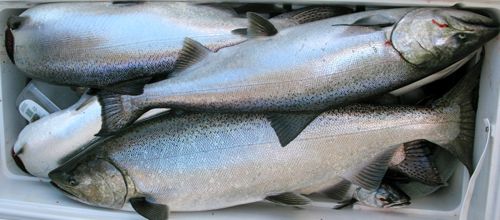The Alaska Department of Fish & Game reports that trollers landed a total of 55,000 kings between October and April, which is their best season since 2005.
But it was that last week of April that re-wrote the record books.
Pattie Skannes is a troll fish management biologist for the state.
“It was impressive to see. Right now, 12,500 fish were harvested during the last full week of this year’s fishery. That’s higher than anything we’ve seen going back to ‘86.”
The winter troll fishery became its own established season in 1981.
The guideline harvest level for the fishery was 47,000 kings. It’s not certain at the moment if that target has been exceeded, since fish produced in Alaska’s hatcheries don’t count against that total.
Skannes says that salmon abundance is so high this year that exceeding the harvest level in the winter is not likely to affect summer fishing.
“I think we’ll be looking at a couple of long openings in July and August. July is likely to be two weeks — maybe three. I don’t think we’ll be hearing too many people bemoaning the fact that we caught a few extra in the winter, if that happens.”
Prices for kings also hit a record this year, averaging over $10 per pound for 2-and-a-half months. Toward the end of the winter fishery, that dropped to around $6 per pound. Averaged over the season, the winter king salmon fishery this year was worth $4.7-million.
Spring fishing opened on May 1, but Skannes says the spring fishery is not an extension of winter fishing. The boundaries shift to inside waters to target salmon returning to the region’s hatcheries.
Skannes says many trollers use the spring to stand down.
“Usually what we see in the spring, at least in the first couple of weeks is a drop in effort and harvest. People usually use the time to do some boat work. Regroup. We’ll get some people venturing out, testing it out, but generally it doesn’t roll right from winter into spring. It will gradually build. Late in May we’ll start seeing a good amount of effort, and the harvest will pick up.
Commercial trollers are allocated the lion’s share of king salmon. They’ll land over 325,000 kings by the end of the summer season. All other gear groups, including sport fishermen, will land about 110,000 fish.
All told, this is about a quarter-million more king salmon this year than last.
One question mark for the fishery is size. Skannes says this year’s winter kings averaged one-pound lighter than fish caught over the last five years. They were one-and-a-half pounds lighter than fish caught over the last ten years.
No one is sure exactly why it’s happening.
“We’ve seen a trend toward decreasing size over a number of years recently. The reasons? There’s speculation about all sorts of reasons.”
Skannes say research biologists are studying the question. There’s evidence that the fish are maturing sooner, and returning to spawn before reaching larger sizes.
































